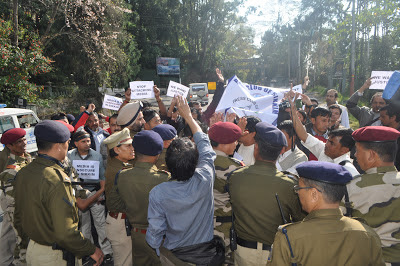Step into the vibrant world of Sikkim! Since 2007, my blog has been a tribute to this beautiful land. Explore Sikkim's history, heritage, sports, cinema, and biodiversity. Discover captivating articles, old videos, cherished photographs and the latest news. Join me in celebrating the essence of Sikkim's culture and natural wonders. Welcome to the oldest running blog on Sikkim!
Saturday, December 29, 2012
Saturday, November 10, 2012
Thursday, November 08, 2012
Saturday, November 03, 2012
Monday, October 29, 2012
Sunday, October 28, 2012
Sikkim’s Sangey Udenla at Doordarshan Television Serial “Ek Tha Rusty”
Sunday, October 21, 2012
Sikkim Postal History: Those early years-iv
 Geoffrey Flack in “Sikkim
Field Force 1888-89; Precursor to the Younghusband Expedition” published in
Postal Himal (No.78, 2nd Quarter 1994) writes ……. on March 20th
1888 Brigadier General T Graham was sent with a force of 2000 men to retake the
lands of Sikkim that was invaded by the Tibetans. The Tibetans offered little
resistance, crossed the Jalepla and attacked Gnatong, The British men forced
the Tibetans to drive them to the frontiers.
Geoffrey Flack in “Sikkim
Field Force 1888-89; Precursor to the Younghusband Expedition” published in
Postal Himal (No.78, 2nd Quarter 1994) writes ……. on March 20th
1888 Brigadier General T Graham was sent with a force of 2000 men to retake the
lands of Sikkim that was invaded by the Tibetans. The Tibetans offered little
resistance, crossed the Jalepla and attacked Gnatong, The British men forced
the Tibetans to drive them to the frontiers.  Sandbach’s correspondence provides a great deal of information
about the postal history of the Sikkim Field Force. Another remarkable cancellation
received from the Sandbach’s correspondence used inside Sikkim are the ‘EXPERIMENTAL
P.O. C-3’ and ‘EXPERIMENTAL P.O C-22’.
Sandbach’s correspondence provides a great deal of information
about the postal history of the Sikkim Field Force. Another remarkable cancellation
received from the Sandbach’s correspondence used inside Sikkim are the ‘EXPERIMENTAL
P.O. C-3’ and ‘EXPERIMENTAL P.O C-22’. Sikkim Postal History: Those early years - iii
For the stamp-sized state of Sikkim, November 6, 2006, held a moment of glory and recognition in terms of world philately. In a group of five lakes from different parts of India, Indian Postage featured a postal stamp on Changu Lake. This Changu Lake stamp with a Rs. 5 denomination can be found among the five Himalayan Lakes of India, including Roop Kund, Sela, Tsomo Riri, and Chandra Tal. Bharati Mirchandani designed the stamp and First Day Cover, and Alka Sharma designed the cancellation.
The stamp is printed by India Security Press in Nasik using the photogravure process. It was the first time in the history of Indian postage stamps that a theme from Sikkim was introduced on an Indian postage stamp. For the last few years, efforts were made to feature individual themes from Sikkim. Along these lines, various tourist destinations, including Rumtek Monastery, Changu (Tsangu) Lake, Guru Dongmor Lake, Nathula Pass, and the cultural diversity of Sikkim, were discussed, but it was the more popular Changu (Tsangu) Lake that made history. Changu Lake has without a doubt been a major tourist attraction over the years. Its incomparable scenic beauty reflects the charisma of the small state of Sikkim.
Sikkim has been fighting for its presence on Indian postal stamps for more than thirty years since the state joined the Indian Union. Apart from four Mt. Kanchenjunga stamps on three separate occasions (1955, 1978, and 1988), Red Panda (1955), Blood Pheasant (1963), Flora and Fauna of North East India (2006), a single illustration of Yumthang valley in the 1982 Himalayan Flowers First Day Cover, and a handful of Sikkim Special Covers, it was a long wait for Sikkim Philately to rejoice.
Although few people know or remember it, Sikkim was home to a unique experiment in mail delivery. In fact, Sikkim was one of the very few nations in the world during the reign of Chogyal, Sikkim's king, to accomplish this ambitious achievement. Among the items sent from the rockets to the confined destinations were parcels, letters, and other items. Rocket mail was being sent across the rivers.
In fact, there are many covers that were successfully delivered that actually have the signature of the late Sir Tashi Namgyal, the Chogyal. In the book “From the diary of Stephen Smith” written by Stephen Smith relating to rocket mail experiments, it has been mentioned that the Sikkim experiment was the most successful among all the pioneering efforts in rocket mail the world over. The five places where the experiments were conducted were Gangtok, Sarumsa, Ray, Singtam, and Rangpo.
Stephen Hector Smith, an Indian rocket mail pioneer, chose Sikkim for his experiment due to its geographical features and mountains. Sikkim is also the first country in the world to successfully dispatch by means of a rocket, a parcel containing small quantities of such useful articles as medicine, tobacco, tea, sugar, etc. Those who helped the Sikkim Rocket experiment succeed included Chogyal Tashi Namgyal, CE Dudley, the General Secretary to the Chogyal, Tashi Dadul Densapa, the Private Secretary, Rai Sahib Faqir Chand Jali, the state engineer, and F Williamson, the British Political Officer.
There cannot be a note on the history of philately in Sikkim without mentioning the Sikkim Revenue Stamps that have been in use since 1917. The oldest known cancellation on a Sikkim Revenue Stamp dates from October 8, 1928, when it was sent from Mangan B.O. to Gangtok. The central design of the stamp depicts the southeast face of Siniolchu, north of Gangtok. The photograph was taken by Hoffmann for the illustration of Claude White’s book, “Sikkim and Bhutan."


















